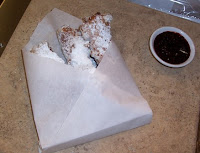Garde Manger
April 4-5, 2011
Week 1
Objectives: Curing and Brining
Recipes: Pork Rillettes, Duck Confit, Duck Prosciutto, Bacon, Canadian Bacon, Pancetta, Pickles
Summary: These are our first nights in the kitchens. I have been looking forward to taking Garde Manger since I finished Fundamentals. The change to the curriculum this quarter is beating me. There is so freaking much homework. Even with having my doctors note for my recipe cards.
This week, I made the Bacon and Pork Rillettes. I burned the hell out of my right forearm on the handle of the pot the Rillettes were in when they came out of the oven.
 |
| Arm Burn |
This picture was taken a week and a half after the burn happened. I hope the Rillettes are going to be worth it!
 |
| Butchering Duck |
 |
| Chicharones |
 |
| Pickles |
 |
| Pickles |
 |
| Pork Belly and Duck |
 |
| Butchering |
 |
| Pork Ribs |
Week 1 Vocabulary
Garde Manger
(to) cure: curing is a process of preserving mostly meats and fish, using salt, sugar, nitrates.
charcuterie: part of what a garde manger chef is responsible for. Things like pate, confit, galatines.
curing compound: usually includes salt, sugar, nitrates, sometimes colored pink. Rubbed on the outside of the meat.
dry cure: meat is coated with the curing compound then usually hung to dry allowing it to age from weeks to maybe over a year.
rub: a rub can be wet or dry. A dry rub is usually made of herbs and spices then rubbed onto the surface of the meat. A wet rub contains some kind of liquid like oil and then coats the meat.
brine: water with salt used to preserve vegetables and meats and sometimes fruit.
brine cure: the process of preserving food by soaking, washing or injecting food with brine.
wet cure: to submerse meat, usually pork that will be used for hams, in brine
pickle: a vegetable, usually a cucumber, submerged in brine for preservation. OR a way to preserve foods for use when they are not in season.
cooked brine: a brine that is heated to help the salt dissolve more quickly.
osmosis: the process of salt entering the cells of the meat.
refined salt: salt that has had all the impurities and minerals removed.
natural salt: salt that has not been refined. Still containing minerals.
kosher salt: refined salt in medium sized particles that dissolve quickly
sea salt: made from evaporating salt water in lagoons.
sodium nitrate: used as a color fixative and preservative for meats in combination with sodium nitrites.
sodium nitrite: used as a color fixative and preservative for meats.
pink cure: curing mixture tinted pink so it won’t be confused with salt.
tinted cure mix (TCM): another name for pink cure. Tinted for safety so that it won’t be confused with salt.
Prague Powder #1: contains 93.75% table salt and 6.25% sodium nitrite.
curing salt: used to cure meats. Tinted pink to prevent it being confused with table salt because it contains nitrates and nitrites.
Prague Powder #2: contains sodium nitrate in addition to sodium nitrite.
cure accelerator: used to help curing compound penetrate meats more quickly
nitrosamines: formed when meats containing nitrates and nitrites are subjected to high heat
humectant: aids in retaining moisture without making things tasting sweeter
pellicle: skin that becomes tacky and translucent from air curing
immersion brining: placing food in a sanitized container with brine covering it
internal brining: applying brine to the inside to the meat
injection brining: using a needle to inject the brine directly to the inside of the meat
arterial brining: using the arteries to inject the brine into the meat. Usually a front or hind leg
food injector: a machine that forces the brine into the meat
brining syringe: a stainless steel chamber with a needle and a plunger
continuous-feed brine pump: a bucket like container for brine that is attached to a hose and needle
(to) corn: the process of applying salt to meat
curing tub: a container to hold the meat layered with curing compound. Usually non-reactive like plastic or stainless steel
overhauling: making sure the cure gets applied evenly by turning a curing item
smoke box: a box where smoke is trapped
smoking chamber: a room or box that holds the smoke for smoking meats
smokehouse: a room or building used for smoking
green wood: wood that had just been cut from trees. it smokes a lot when burnt
aged wood: stored away from moisture and insects for at least a year after harvesting
seasoned wood: the same as aged wood. Been held away from moisture and insects for up to a year
cold smoking: smoking meat at a temperature below 100° F or 37° C
hot smoking: food that is hung in a smoke filled room that is between 150° F and 200° F
rendering: cooking meat slowly to release the fat in the connective tissues
semisolid fat: like butter, fat that becomes semisolid when chilled
confit: cured meat that is then sealed in fat like duck
rillettes: meat cooked in seasoned liquid, then shredded and sealed in fat
potted meat: meat that has been cured then cooked in lard and sealed in fat
mellowing: time for the food to release oils and marry the flavors
Week 2, Day 2
Objectives: Simple Plated Salads, Composed Salads and Buffet Salads, Gravlox Demo
Recipes: Contemporary Caesar, Simple green salad, Butter Lettuce with Dijon Vinaigrette, Hollywood Cobb Salad, Classical Nicoise Salad, Green Bean and Jicama, Pear Salad, Asian Chicken Salad, French Lentil Salad, Mixed Bean Salad with Red Wine Vinegar and Duck Confit, Chinese Noodle Salad, Garden Pasta Salad
Summary: Salads this week. I like the Caesar Salad. It is one of my favorites. I would have put a little more dressing on it, ours seemed a little dry. The Simple Green Salad was ok. I like Frisee lettuce and at home I use it for my salads. Frisee is from the endive family! I like to toss it with a light vinaigrette and then add a poached egg and some bacon crumbles! Diego flubbed the plating of our Hollywood Cobb Salad. I know he is young but I am trying to not baby him so we let him plate it on his own. I think sometimes he doesn’t read through the instructions before class or while we are working in class. It frustrates me because he was on my team in American Regional and so he followed me to my table in Garde Manger and I can’t tell him that we don’t want him on our team. Anyway, I liked the day two salads. The Asian Chicken Salad was my favorite of the day, although I did eat all the confit off the salads.
Week 2 Vocabulary
complex salad: A salad that has a base of lettuce and then other things like a tuna salad or a cobb salad
simple salad: a simple salad is one of greens and maybe tomatoes, onions and cucumbers with dressing
tossed salad: similar to a simple salad, all the ingredients are tossed together with the dressing and presented on the plate
sprouts: like alfalfa sprouts. Used in salads and on sandwiches. Or greens that have just sprouted their first set of leaves.
micro greens: a little older than sprouts, have grown more leaves and need sunlight
baby greens: greens that are the next step older than micro greens
proprietary greens mix: a mixture of salad greens sold under a brand name
mesclun: a mix of baby lettuces like red chicory and arugula
spring mix: a mix of lettuces that are specialty greens or baby greens
pluche: tiny leaves of herbs
edible flowers: things like nasturtium and pansy’s that are safe to eat
hydroponics: growing in water based nutrients
“living” greens: lettuces that still have the root ball attached and are sold in a little bit of water
turgid: firm, fresh leaves with no damage
rust: the discoloration on lettuce leaves. Caused by cutting or bruising
bolted: when the lettuce is extremely overripe
mixed presentation: a salad like a cob that has been mixed all together instead of having each ingredient separate
arranged presentation: salads that have been dressed and are presented separately on the plate
liner leaf: a big leaf that is placed on the plate and then topped with the other salads
bed of greens: the base of a complex salad. The greens at the bottom of the plate
complex side salad: a smaller version of a complex salad used as a side dish
bound protein salad: a salad that has as its main focus a meat protein like chunks of chicken or turkey
complete salad: a salad that has vegetables, proteins and starch
fruit salad: a salad made of fruits, sometimes dressed with a whipped cream dressing and sometimes served plain
water out: to extract the water from something
arranged salad: a salad that has many different ingredients arranged in a specific design or pattern
plate painting: drawing designs on the plate with sauces
bedded presentation: salads that are placed on a liner leaf
plate rim: the raised edge of the plate
plate well: the center of the plate where the food goes
front of the plate: the side of the plate nearest the guest
back of the plate: the side of the plate away from the guest
o’clock: one of the stations on the plate, like 3 o’clock would be to the right side of the plate facing the gurst. The front of the plate would be 6 o’clock and would be at the guest.
mounded presentation: arranging separate piles of the ingredients on the plate
flat presentation: presentation where the elements are placed flat on the platter
molded presentation: using rings or scoops to place the salad in a shape on the plate
socle: a molded base
plinth: a square block that is used as a base for a buffet table
The Gravlox demo was really interesting. I kept hearing in my head the “fish heads” song.
 |
| Asian Chicken Salad |
 |
Pear and Blue Cheese Salad
and Blue Cheese Tart |
 |
| Chinese Noodle Salad |
 |
| Classic Caesar Salad |
 |
| Classical Nicoise Salad |
 |
Fish Heads, Fish Heads
Rolly Polly Fish Heads |
 |
| French Lentil Salad |
 |
| Garden Pasta Salad |
 |
| Green Bean and Jicama Salad |
 |
| Salmon Gills |
 |
| Hollywood Cobb Salad |
 |
| Chef Filletring Salmon |
 |
Green Bean and Duck Confit
Salad |
 |
Whole Salmon ready to be
Filletted |































































